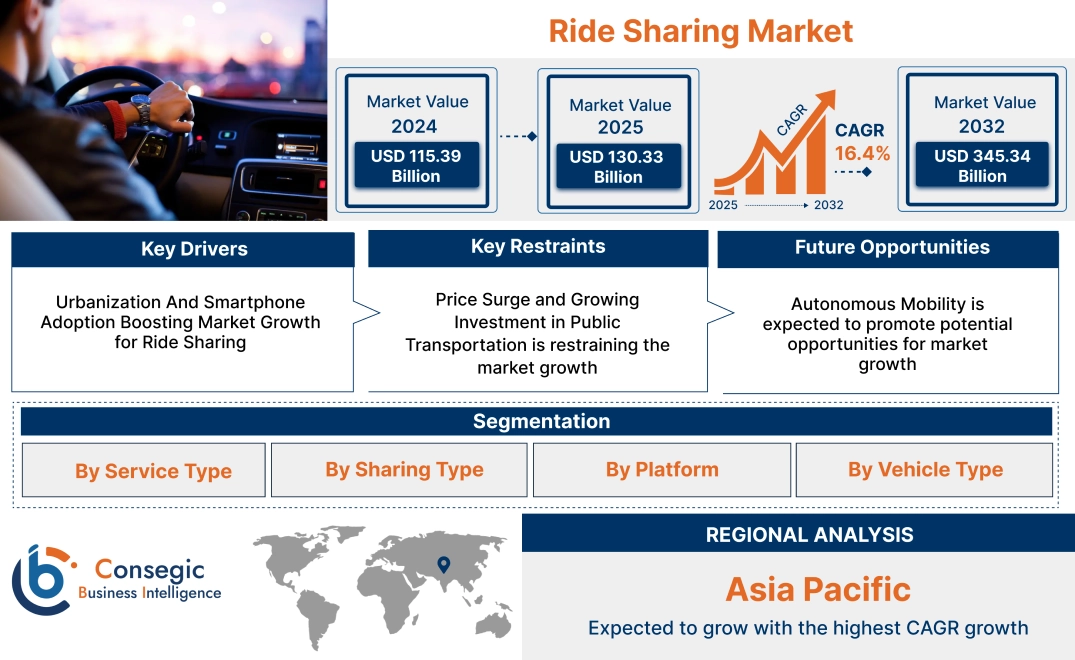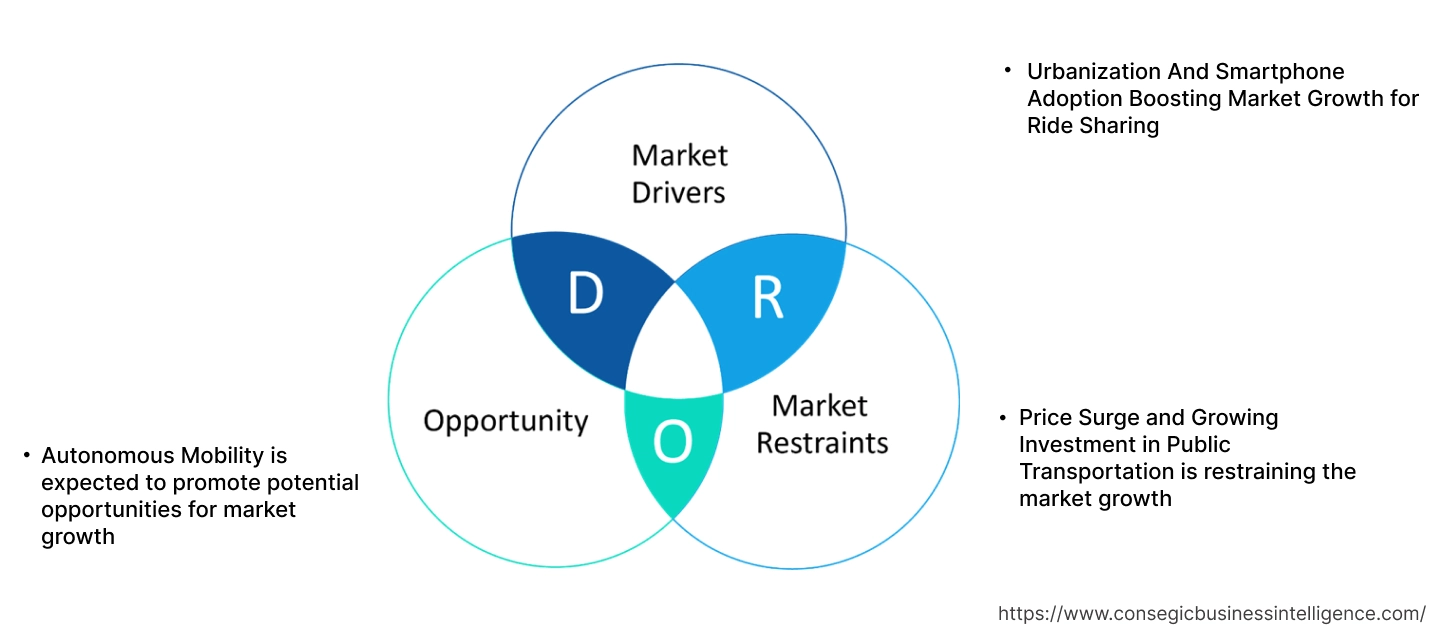- Summary
- Table Of Content
- Methodology
Ride Sharing Market Size:
Ride Sharing Market size is estimated to reach over USD 345.34 Billion by 2032 from a value of USD 115.39 Billion in 2024 and is projected to grow by USD 130.33 Billion in 2025, growing at a CAGR of 16.4% from 2025 to 2032.
Ride Sharing Market Scope & Overview:
The ride sharing service involves the utilization of app to connect passengers with drivers for rides in turn offering a convenient, affordable, and efficient alternative to traditional modes of transportation, such as taxis and personal vehicles. Additionally, the advantages including convenience, accessibility, cost-effectiveness, reduced traffic congestion, and lower carbon emissions among others are driving the ride sharing market demand. Further, the proliferation of pooling sharing services due to its convenience and cost-effectiveness is driving the ride sharing market growth.
Key Drivers:
Urbanization And Smartphone Adoption Boosting Market Growth for Ride Sharing
The increasing urbanization and rising smartphone adoption is paving the way for adoption of ride hailing services across the globe which in turn drives the ride sharing market growth. Additionally, the proliferation of 4G and 5G networks enables real-time data sharing, optimized traffic flow, and others. Further, smartphone adoption makes ride booking and payment accessible and convenient in turn driving the ride sharing market demand.
- For instance, in October 2023, according to the GSMA report, 54% of the global population owns a smartphone as well as 49% of the world’s population is utilizing mobile internet service driving the adoption of ride sharing industry.
Therefore, the increasing urbanization and rising smartphone adoption is driving the adoption of ride hailing service, in turn proliferating the growth of the market.
Key Restraints:
Price Surge and Growing Investment in Public Transportation is restraining the market growth
The real time demand for ride increases due to bad weather, rush hour, and special events, among others, in turn increase the price as compared to traditional prices which in turn hinders the ride sharing market expansion. Additionally, public transportation is more sustainable options for moving large numbers of people efficiently in turn hinders the market development. Further, the rising investment in the adoption of electric public transportation is restraining the market development.
Therefore, the surge price and adoption of public transportation are restraining the ride sharing market expansion.
Future Opportunities:
Autonomous Mobility is expected to promote potential opportunities for market growth
The rising focus towards integration of autonomous vehicles with ride sharing platforms to offer on-demand, efficient, and potentially cheaper mobility options to revolutionize urban transportation which in turn is driving the ride sharing market opportunities. Additionally, the integration makes transportation more reliable, affordable, sustainable, and safer in turn driving the market development.
- For instance, in January 2025, Uber Technologies, Inc. collaborated with NVIDIAfor the development of AI-powered autonomous driving technology. Additionally, the collaboration aims to leverage NVIDIA Cosmos platform and NVIDIA DGX Cloud to build efficient AI partners.
Hence, the rising integration of autonomous vehicles with ride sharing platforms is anticipated to increase the utilization, in turn promoting prospect for ride sharing market opportunities during the forecast period.
Ride Sharing Market Segmental Analysis :
By Service Type:
Based on the service type, the market is segmented into e-hailing, ride sharing, car rental, and station-based mobility.
Trends in the Service Type:
- The increasing focus towards sustainability is driving the adoption of ride hailing services which in turn drives the ride sharing market trend.
- The smart city initiative is driving the adoption of station-based mobility services which in turn drives the ride sharing market trend.
E-Hailing accounted for the largest revenue share in the year 2024.
- E-Hailing is a service type allowing passengers to book a ride using a smartphone app.
- Additionally, the advantages of utilizing e-hailing services include convenience, accessibility, and safety, fueling the ride sharing market share.
- Further, the increasing traffic congestion, and a demand for convenient transportation solutions is driving the demand for e-hailing service which in turn is boosting the ride sharing market share.
- For instance, in March 2023, Dubai's roads and transport authority authorized a plan to shift from conventional taxi hail service to e-hail services in turn driving the e-hailing service development.
- Thus, according to the ride sharing market analysis, increasing traffic congestion, and need for convenient transportation solutions are driving the e-hailing service segment.
Car Rental is anticipated to register the fastest CAGR during the forecast period.
- Car rental service provides short time leasing vehicles for a specified time with charges specific to time to their customers.
- Additionally, the advantages of car rental service include flexibility, convenience, and access to various vehicles drives the ride sharing market size.
- Further, digital transformation with the proliferation of online bookings, mobile apps, and contactless transactions is propelling the car rental service segment which in turn drives the ride sharing market size.
- Therefore, as per the market analysis, the digital transformation is anticipated to boost the market during the forecast period.
By Sharing Type:
Based on the sharing type, the market is segmented into business-to-consumer (B2C), business-to-business (B2B), and peer-to-peer (P2P).
Trends in the Sharing Type:
- The trend towards rising adoption of peer-to-peer type segment due to cost-effectiveness, reduced traffic congestion, and sustainability solutions is driving the market progress.
- The consumer shift towards convenient and affordable ride hailing solution is driving the business-to-consumer type segment trend.
Business-to-Consumer (B2C) accounted for the largest revenue share of 57.92% in the year 2024.
- The rising adoption of ride hailing application is driving the business-to-consumer segment progress.
- Additionally, the business-to-consumer segment offers minimized liability or no ownership of vehicles for the customers is driving the ride hailing application industry.
- Further, the rise of electric and autonomous vehicles is driving the business-to-consumer segment.
- Thus, as per the market analysis, rise of electric and autonomous vehicles is driving the business-to-consumer segment.
Business-to-Business (B2B) is anticipated to register the fastest CAGR during the forecast period.
- The ride hailing service platforms are leveraged by companies to provide employee commutes, business travel, and event transportation among other services which is a cost-effective solution for companies.
- Additionally, the advantages of business-to-business platform type includes efficiency and convenience. Also, the need for affordable transportation is driving the business-to-business platform type segment progress.
- For instance, in December 2024, TA Connections collaborated with uber for business. The collaboration aims to integrate TA Disruption Hub allowing airlines to assist disrupted passengers by scheduling Uber rides for passengers.
- Therefore, according to the ride sharing market analysis, the need for affordable transportation is anticipated to boost the market during the forecast period.
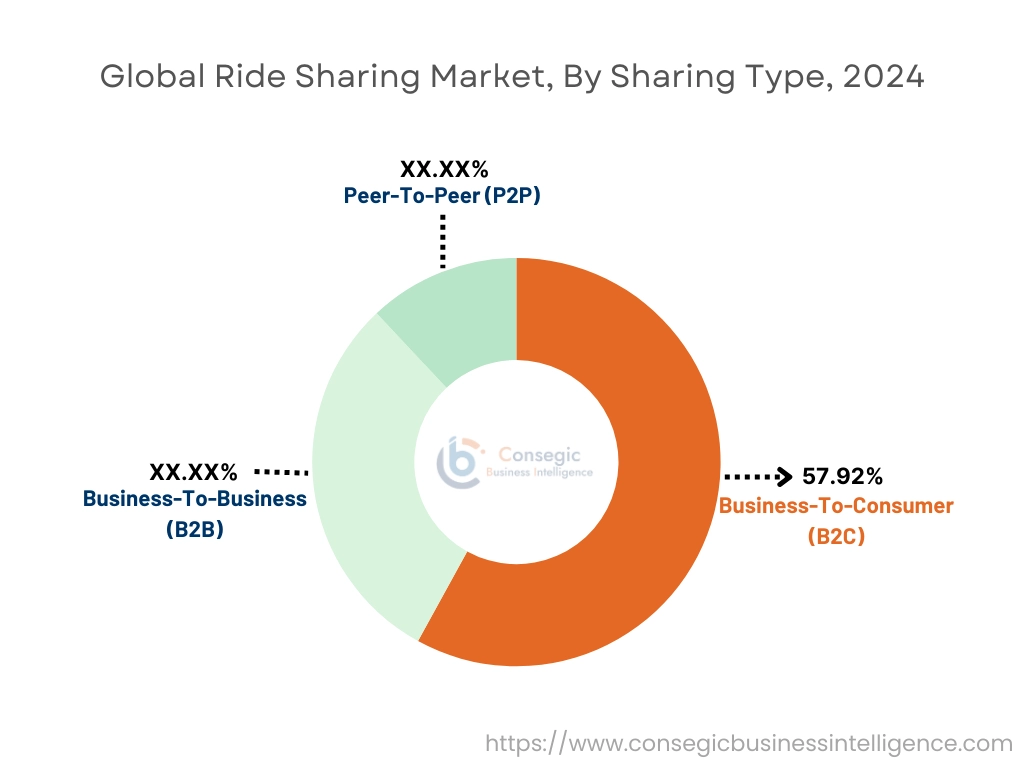
By Platform:
Based on the platform, the market is segmented into web-based, app-based, and web & app based.
Trends in the Platform:
- The rise of AI and ML for enhancing user experiences and personalization is driving the adoption of web-based platforms segment.
- The rise in mobile penetration is driving the adoption of app-based platform segment.
App-based accounted for the largest revenue share in the year 2024.
- The shift from conventional ride hailing services to e-hailing services is driving the need for app-based platform segment.
- Additionally, the increasing focus towards sustainability is driving the adoption of electric vehicles for ride hailing is driving the app-based platform segment.
- For instance, in May 2023, Waymo partnered with Uber for expanding availability of Waymo Driver via the Uber app. Also, the riders are leveraging Waymo One app for hailing a Waymo vehicle.
- Thus, as per the market analysis, increasing focus towards sustainability as well as adoption of electric vehicles is driving the app-based platform development.
Web & App Based is anticipated to register the fastest CAGR during the forecast period.
- The integration of web & app-based ride hailing services with autonomous vehicles is driving the development of web & app-based platform segment.
- Further, the integration of AI into web & app-based platform for optimizing routes and need prediction is driving the segment progress.
- Therefore, the integration of AI is anticipated to boost the market during the forecast period.
By Vehicle Type:
Based on the vehicle type, the market is segmented into ICE vehicle, CNG/LPG vehicle, and electric vehicle.
Trends in the Vehicle Type:
- The trend towards adoption of cost-effective solutions compared to petrol and diesel is driving the adoption of CNG/LPG vehicle for ride hailing services.
- The trend towards government support and subsidiaries towards the adoption of CNG/LPG vehicles is driving the market development.
ICE vehicle accounted for the largest revenue share in the year 2024.
- The ICE vehicles are cost effective compared to electric vehicles in turn driving the adoption of ICE vehicle for ride hailing.
- Additionally, the well-established network of fuel stations and maintenance facilities drives the adoption of ICE vehicles.
- Further, the need for long-range capabilities compared to electric vehicles in turn driving the adoption of ICE vehicle for ride hailing.
- Thus, as per the market analysis, the need for long-range capabilities is driving the adoption of ICE vehicles segment.
Electric Vehicle is anticipated to register the fastest CAGR during the forecast period.
- The increasing focus towards adoption of sustainable transportation solutions as well as reducing carbon footprint is driving the adoption of electric vehicles in the ride hailing market.
- Further, the charging infrastructure development is paving the way for adoption of electric vehicles.
- For instance, in March 2025, Uber partnered with refex green mobility for the deployment of 1000 electric four-wheelers in India. Also, the deployment is a step towards achieving 100% emission-free rides.
- Therefore, as per the market analysis, the increasing focus towards adoption of sustainable transportation solutions as well as reducing carbon footprint is anticipated to boost the market during the forecast period.
Regional Analysis:
The regions covered are North America, Europe, Asia Pacific, Middle East and Africa, and Latin America.
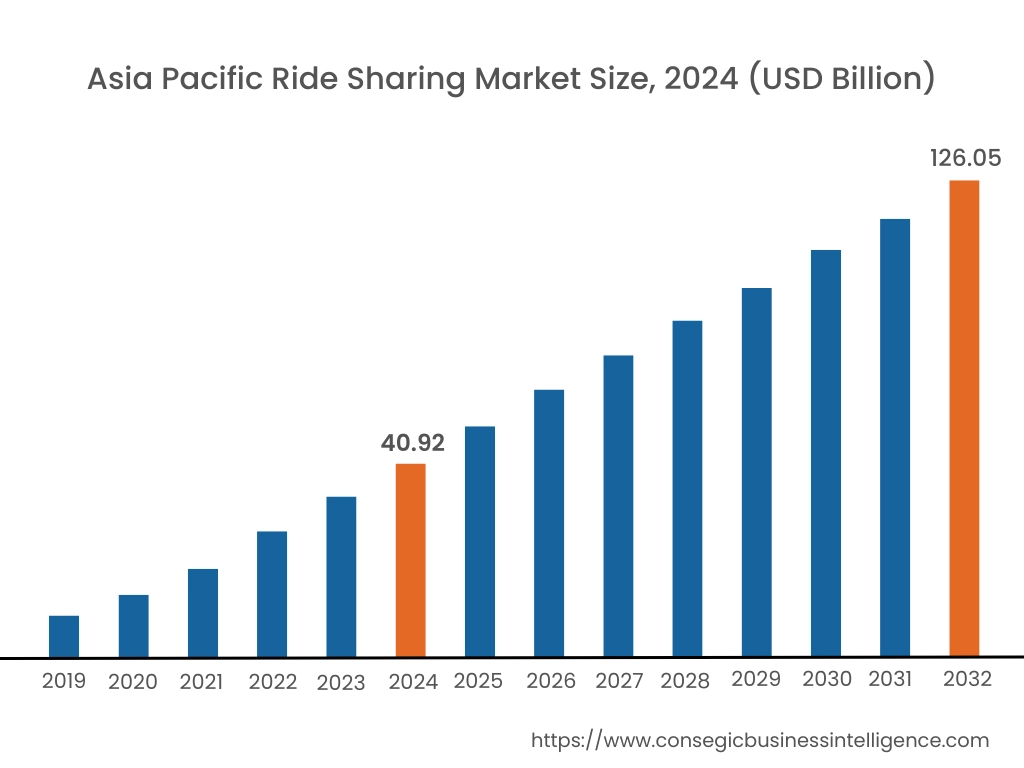
Asia Pacific region was valued at USD 40.92 Billion in 2024. Moreover, it is projected to grow by USD 46.34 Billion in 2025 and reach over USD 126.05 Billion by 2032. Out of this, China accounted for the maximum revenue share of 32.51%. The market progress is mainly driven by convenient and cost-effective solutions compared to traditional operation. Furthermore, factors including urbanization and rising adoption of electric vehicles are projected to drive the market evolution in Asia Pacific region during the forecast period.
- For instance, in February 2025, Uber launched Uber Saarthi in Assam with the an funding of USD 1.2 billion from Government of Assam. The launch aims to provide shared mobility solutions which optimize assets by creating prospects for taxi services.
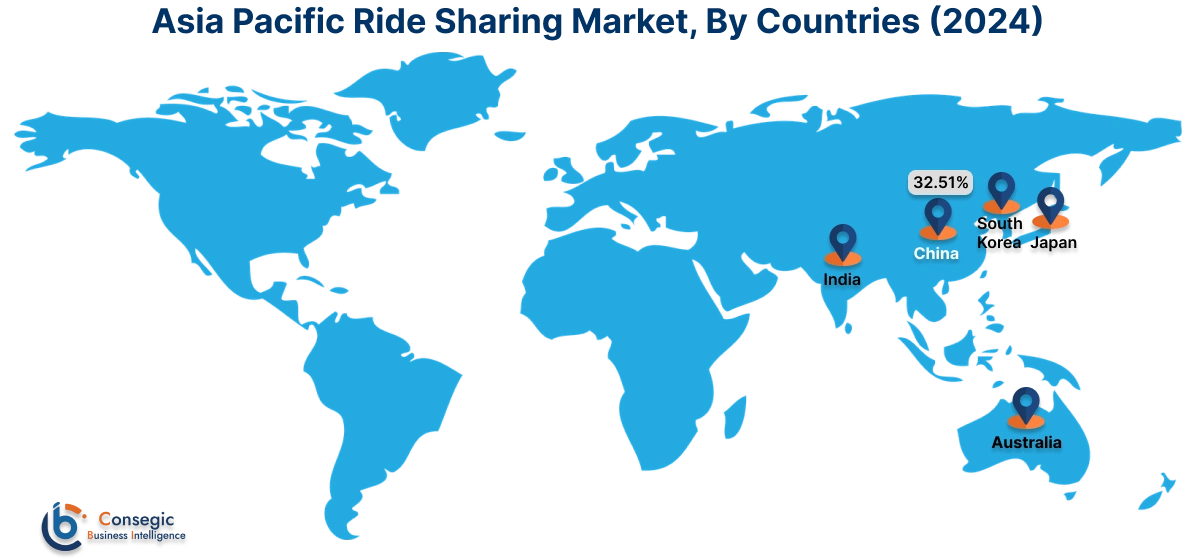
North America is estimated to reach over USD 87.03 Billion by 2032 from a value of USD 29.35 Billion in 2024 and is projected to grow by USD 33.12 Billion in 2025. The North American region's market is rising due to adoption of autonomous vehicles and ridesharing services offer lucrative growth prospects for the market. Additionally, the rising focus towards providing high-performance and seamless payments experiences is driving the market progress.
- For instance, in September 2023, PayPal Holdings, Inc. partnered with Uber Technologies, Inc. to offer high-performance and seamless payments experiences for Uber's customers.
The regional evaluation depicts that the urbanization as well as increasing adoption of autonomous vehicles is driving the market in Europe. Additionally, the key factor driving the market is increasing competition among different platforms in the Middle East and African region. Further, the smartphone adoption as well as rising transportation needs is paving the way for the progress of market in Latin America region.
Top Key Players & Market Share Insights:
The global ride sharing market is highly competitive with major players providing ride hailing to the national and international markets. Key players are adopting several strategies in research and development (R&D), product innovation, and end-user launches to hold a strong position in the ride sharing industry. Key players in the ride sharing market include-
- ANI Technologies Pvt. Ltd. (OLA) (India)
- Beijing Xiaoju Technology Co Ltd. (Didi Chuxing) (China)
- Grab (Singapore)
- Lyft Inc. (USA)
- Taxify OÜ (Europe)
- BlaBlaCar Inc. (Paris)
- (Spain)
- Careem (UAE)
- Curb Mobility (USA)
- Gett (UK)
Recent Industry Developments :
Mergers & Acquisitions:
- In July 2024, Triple J Enterprises acquired Stroll for strengthening portfolio and commitment to providing innovative transportation solutions. Additionally, the acquisition aims to cater challenges such as high taxi prices and non-existent public transport.
Partnerships & Collaborations:
- In March 2025, Waymo partnered with Uber for the integration of Waymo autonomous electric vehicle with the Uber app for operations in Austin, USA.
- In October 2024, Uber partnered with Shadowfax to integrate two-wheeler fleet with the ride-hailing platform to offer bike-taxi service. The partnership aims to strengthen bike-taxi operations market.
Ride Sharing Market Report Insights:
| Report Attributes | Report Details |
| Study Timeline | 2019-2032 |
| Market Size in 2032 | USD 345.34 Billion |
| CAGR (2025-2032) | 16.4% |
| By Service Type |
|
| By Sharing Type |
|
| By Platform |
|
| By Vehicle Type |
|
| By Region |
|
| Key Players |
|
| North America | U.S. Canada Mexico |
| Europe | U.K. Germany France Spain Italy Russia Benelux Rest of Europe |
| APAC | China South Korea Japan India Australia ASEAN Rest of Asia-Pacific |
| Middle East and Africa | GCC Turkey South Africa Rest of MEA |
| LATAM | Brazil Argentina Chile Rest of LATAM |
| Report Coverage |
|
Key Questions Answered in the Report
How big is the ride sharing market? +
The ride sharing market size is estimated to reach over USD 345.34 billion by 2032 from a value of USD 115.39 billion in 2024 and is projected to grow by USD 130.33 billion in 2025, growing at a CAGR of 16.4% from 2025 to 2032.
What specific segmentation details are covered in the ride sharing report? +
The ride sharing report includes specific segmentation details for service type, sharing type, platform, vehicle type and regions.
Which is the fastest segment anticipated to impact the market growth? +
In the ride sharing market, the electric vehicle is the fastest-growing segment during the forecast period due to increasing focus towards adoption of sustainable transportation solutions as well as reducing carbon footprint.
Who are the major players in the ride sharing market? +
The key participants in the ride sharing market are ANI Technologies Pvt. Ltd. (OLA) (India), Beijing Xiaoju Technology Co Ltd. (Didi Chuxing) (China), BlaBlaCar Inc. (Paris), Cabify. (Spain), Careem (UAE), Curb Mobility (USA), Gett (UK), Grab (Singapore), Lyft Inc. (USA), Taxify OÜ (Europe), and others.
What are the key trends in the ride sharing market? +
The ride sharing market is being shaped by several key trends including trend towards rise of AI and ML for enhancing user experiences and personalization as well as increasing focus towards sustainability is driving the adoption of ride hailing services and other are the key trends driving the market.
